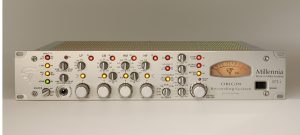The EQ section of the STT-1 is virtually identical to the EQ that is in Millennia’s NSEQ-2. Millennia’s EQ features a 4-band parametric EQ that enables you to choose either a class-A vacuum tube signal path, or a more transparent, class-A solid-state alternative. With the STT-1, the input and the EQ section can each be switched between tube and solid state for even more tonal variability. Out of the 4 bands, the LF and HF have selectable frequencies and can be switched between peak and shelf. The 2 mid bands on the STT-1 have continuously variable frequencies, plus or minus 15. This range is selectable between 10 and 20 dB on the NSEQ-2. The mid frequencies also have a narrow Q at 4.0 to a wide Q at 0.4. The x10 selection even allows for extremely high frequencies of up to 25k for putting air into your tracks.
In our series of EQ videos, we listen to some piano tracks, saxophone, and electric guitar. In the videos, you can listen to the difference between the vacuum tube and solid-state input. There are some subtle differences listening to the input stage as either tube or solid state as well as the second stage at the EQ and compressor. On the STT-1, there is also the option of putting the Millennia MIT-01 audio path transformer in the front-end circuit. This can fatten up the sound feeding the EQ. The Millennia EQ has the ability to be extremely surgical, great for removing specific frequency problems, or it can add wider sonic changes if the need arises. In the first Millennia EQ video, you can listen to the bari-saxophone track as we use the EQ to remove what might be trouble frequencies affecting our ability to place this saxophone in a mix. Using a narrow Q and a large boost, we can find the trouble frequencies. In this particular case it is around 500Hz. After finding the trouble frequency, we can remove it from the saxophone track. We can also add a little air to the track by boosting the frequencies above 21Khz.
Millennia’s EQ can not only be used for situations that call for detailed surgery, but it can also be used to create many different tones and colors out of the instrument you are recording. In our third EQ video, we listen to a rock track recorded by Scott Sawyer, and demonstrate several different possible colors. It all depends on what you are looking for, but this is an incredible piece of equipment for making instruments of any kind sit where you want them in the mix.  In the second EQ video, we listen to a jazz piano track recorded on a Steinway Grand. Steinway Grands can have a fairly dark sound. There are many instances where you may want to brighten up the sound of these tracks. You can add extra enhancements and different colorations from the Millennia EQ. In our piano track, we have shelved down slightly at 34 Hz , added a boost around 4k with a medium Q, and also added a high-frequency shelf boost at 16k, bringing out the upper end on the piano. The Millennia STT-1/NSEQ-2 can be used effectively on everything from distorted guitars to drums, sax, and piano. It can add color and personality to rock tracks, or behave very neutrally, correcting only the EQ frequencies that need correcting without coloring at all, by choosing the tube and transformer settings that best suit the track. It’s certainly clean and accurate enough to use on jazz and classical music, but we love to use it on everything from hip hop to rock ‘n’ roll.
In the second EQ video, we listen to a jazz piano track recorded on a Steinway Grand. Steinway Grands can have a fairly dark sound. There are many instances where you may want to brighten up the sound of these tracks. You can add extra enhancements and different colorations from the Millennia EQ. In our piano track, we have shelved down slightly at 34 Hz , added a boost around 4k with a medium Q, and also added a high-frequency shelf boost at 16k, bringing out the upper end on the piano. The Millennia STT-1/NSEQ-2 can be used effectively on everything from distorted guitars to drums, sax, and piano. It can add color and personality to rock tracks, or behave very neutrally, correcting only the EQ frequencies that need correcting without coloring at all, by choosing the tube and transformer settings that best suit the track. It’s certainly clean and accurate enough to use on jazz and classical music, but we love to use it on everything from hip hop to rock ‘n’ roll.


